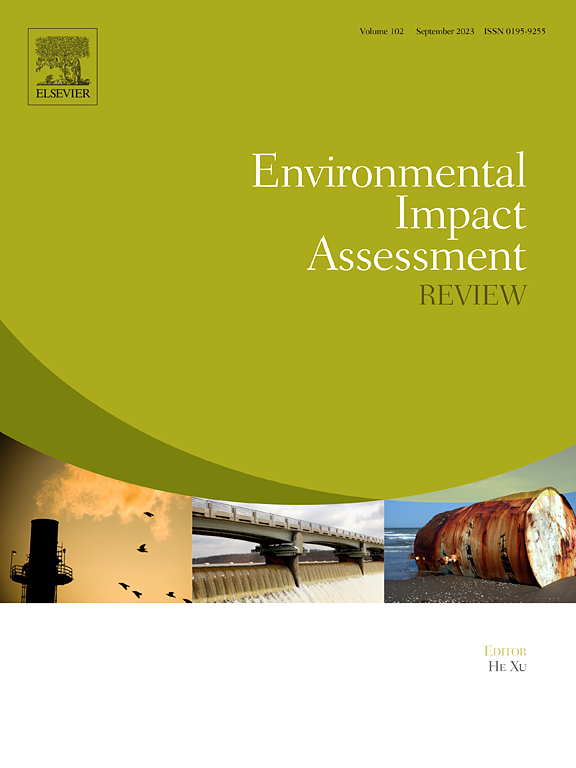Sustainable thermal conversion of waste wind turbine blades: Environmental impact and pollutant footprint analysis
IF 9.8
1区 社会学
Q1 ENVIRONMENTAL STUDIES
引用次数: 0
Abstract
The sustainable management of decommissioned wind turbine blades (WTBs) is critical for advancing renewable energy and mitigating environmental impacts. This study evaluates the environmental footprint of vacuum pyrolysis and incineration for WTB treatment, focusing on pollutant formation mechanisms and health risks. We compared the efficiency and environmental impacts of both methods. Results revealed that incineration generated significant hazardous emissions, including toluene (10.58 %, HQ = 2.90) and xylenes (4.05 %, HQ = 55.44) posing severe non-carcinogenic risks. In contrast, vacuum pyrolysis drastically reduced these pollutants (toluene: 2.38 %, HQ = 0.65; xylenes: 1.07 %, HQ = 14.62) with lower health hazards. Specifically, vacuum pyrolysis reduced the emissions of toluene and xylene by 77.50 % and 73.58 %, respectively. Structural characterization confirmed that vacuum pyrolysis preserved fiber integrity while removing 69 % of organic resin. Therefore, vacuum pyrolysis holds certain advantages in the recovery of fibers from WTBs. Molecular dynamics simulations elucidated that pollutant formation (e.g., toluene and xylenes) stemmed from radical-driven Friedel-Crafts alkylation reactions, with incineration exhibiting higher radical diversity and pollutant yields. Compared to nitrogen pyrolysis, vacuum pyrolysis avoided carcinogenic styrene emissions and demonstrated superior cost-effectiveness. The phase analysis further highlighted vacuum pyrolysis' advantages in energy efficiency (36 % recoverable oil) and carbon reduction, despite higher equipment requirements. This study provides mechanistic insights and empirical evidence supporting vacuum pyrolysis as a greener, scalable alternative for WTB recycling, aligning with global sustainability goals.
废弃风力涡轮机叶片的可持续热转换:环境影响和污染物足迹分析
退役风力涡轮机叶片的可持续管理对于推进可再生能源和减轻环境影响至关重要。本研究评估了真空热解和焚烧处理WTB的环境足迹,重点关注污染物形成机制和健康风险。我们比较了两种方法的效率和环境影响。结果表明,焚烧产生了大量有害物质,其中甲苯(10.58%,HQ = 2.90)和二甲苯(4.05%,HQ = 55.44)具有严重的非致癌风险。相比之下,真空热解显著减少了这些污染物(甲苯:2.38%,HQ = 0.65;二甲苯:1.07%,HQ = 14.62),健康危害较低。其中,真空热解的甲苯和二甲苯排放量分别减少了77.50%和73.58%。结构表征证实,真空热解保留了纤维的完整性,同时去除了69%的有机树脂。因此,真空热解在回收废纺织物纤维方面具有一定的优势。分子动力学模拟表明,污染物的形成(如甲苯和二甲苯)源于自由基驱动的Friedel-Crafts烷基化反应,焚烧表现出更高的自由基多样性和污染物产率。与氮气热解相比,真空热解避免了致癌物苯乙烯的排放,并显示出更高的成本效益。相分析进一步强调了真空热解在能源效率(36%的可采油)和碳减排方面的优势,尽管对设备的要求更高。该研究提供了机理见解和经验证据,支持真空热解作为一种更环保、可扩展的垃圾回收替代方案,与全球可持续发展目标保持一致。
本文章由计算机程序翻译,如有差异,请以英文原文为准。
求助全文
约1分钟内获得全文
求助全文
来源期刊

Environmental Impact Assessment Review
ENVIRONMENTAL STUDIES-
CiteScore
12.60
自引率
10.10%
发文量
200
审稿时长
33 days
期刊介绍:
Environmental Impact Assessment Review is an interdisciplinary journal that serves a global audience of practitioners, policymakers, and academics involved in assessing the environmental impact of policies, projects, processes, and products. The journal focuses on innovative theory and practice in environmental impact assessment (EIA). Papers are expected to present innovative ideas, be topical, and coherent. The journal emphasizes concepts, methods, techniques, approaches, and systems related to EIA theory and practice.
 求助内容:
求助内容: 应助结果提醒方式:
应助结果提醒方式:


